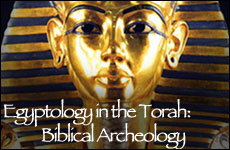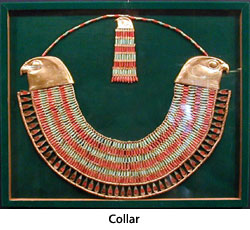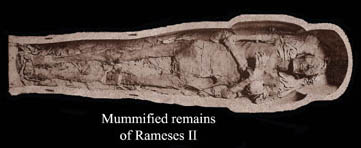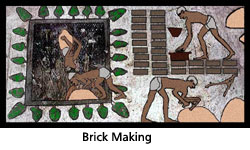 Iran’s Attack on Israel
Iran’s Attack on Israel


17 min read
Contrary to popular Egyptologist belief, the Torah does contain numerous hints of contemporary life in ancient Egypt.
The western world has a fascination with the culture of ancient Egypt. The image of the great stone sphinx guarding the lofty pyramiding tombs of the mummified pharaohs, as the once all-powerful king journeyed through the world of darkness, adds to the mysterious lure of ancient Egypt. Over 100,000 books have been written on this inscrutable land and its pharaohs, the first one being composed over 2000 years ago. By the time the Hellenistic historian, Manetho, composed his Aegyptiaca in the third century BCE, the pharaoh of the Exodus had already been mummified about 1,000 earlier.
For the Jewish People, ancient Egypt has a much deeper allure. Much of the first two books of the Torah takes place in Egypt. [1] The experience of the Israelites in Egypt is so important to the centrality of Judaism that the Exodus from Egypt is mentioned in the very opening of the Ten Commandments. "I am the Lord your God, who have brought you out of the land of Egypt, out of the house of slavery dus 20:2)"
Egyptologists have expressed disappointment that almost nothing relating to ancient Egyptian life or culture can be gleaned from the Bible. This has lead many, such as Egyptologist Donald Redford of Pennsylvania State University to disparagingly claim, "The Hebrew writer (of the Bible) was not so well acquainted with Egypt as has often been imagined." [2]
Egyptologists claim that the Torah was composed 8-10 centuries after the Exodus and the "Biblical author(s)" had no idea what was going on in ancient Egypt. They are mistaken.
For us, the lack of cultural references is quite understandable because the Torah is neither a history book nor an anthropological record of ancient societies but rather it is a guide for everyday life based on human nature and the spiritual loftiness of the Jewish soul and these elements are timeless. However, many Egyptologists have taken a different approach. They claim that the Torah was composed 8-10 centuries after the Exodus and the "Biblical author(s)" had no idea what was going on in ancient Egypt. Therefore, these Egyptologists claim, the Torah had no choice but to remain silent about ancient Egyptian practices.
Not only are they wrong about when the Torah was composed and by Whom, these Egyptologists are also quite mistaken if they think there are no revelations to be found in the Torah reflecting ancient Egyptian life. Let us see for ourselves.
1. "And they sold Joseph to the Ishmaelites for 20 pieces of silver; and they brought Joseph to Egypt" (Genesis 37:28). In ancient times, just as in our day and age, prices slowly but steadily increased over the course of time. In ancient Ur, circa 2000 BCE, a slave would cost 10-15 pieces of silver (shekels). During the reign of the Hammurabi dynasty, the price increased slightly, to about 20 pieces of silver. For a while, the price of a slave remained fairly stable but by the last quarter of the second millennium BCE., the price crept up to 30 shekels. During the first quarter of the Assyrian Empire, a healthy slave could fetch 50-60 pieces of silver and by the middle of the first millennium, the price of a slave soared to over 100 shekels.[3] When the Torah tells us that Joseph was sold for 20 pieces of silver it was an accurate reflection of the price of a slave in Canaan/Egypt at that time period, about 1500 BCE according to our Biblical chronology.
2. The Torah (Genesis 37:36) tells us that the name of Joseph's slave-master was Potiphar. It later tells us that Joseph's wife's name was Asenath (Genesis 41:45). These were in fact Egyptian names in use in Egypt during the time of Joseph, though they were quite unusual and later fell into disuse. Biblical "author(s)" not aware of these obscure ancient names could never have used them.[4]
Torah uses the exact expression the contemporary Egyptians used for the foreman of the servants and slaves.
3. The Torah tells us that Joseph was the overseer of Potiphar's estate. There are many possible titles one can give the chief slave or servant. The Torah chose to call Joseph the one "Over the house" (Genesis 39:4). The Papyrus Brooklyn 53.1446 refers to a chief slave and gives his proper title as the one who was "Over the house."[5] We see that the Torah is using the exact expression the contemporary Egyptians used for the foreman of the servants and slaves.
4- "And Joseph's master took him, and put him in the prison, a place where the king's prisoners were confined" (Genesis 39:20). Due to the false accusations of Potiphar's wife, Joseph was thrown into a prison. The concept of imprisonment was not widespread in the ancient world of the early Biblical era. In the Torah itself, we do not find any mention of imprisonment being a form of punishment. We do find that the son of Shelomith, who cursed God, was held in confinement, but that was only until the correct punishment could be determined. The actual detention was not a punishment. In the ancient world, those convicted of crimes were generally killed, tortured, mutilated or made to compensate monetarily. The concept of imprisonment was almost unheard of. Egypt was one of the very few exceptions to have prisons. Many of the isolated fortresses that guarded the borders of ancient Egypt also served as royal prisons.[6]
5. "Then Pharaoh sent and called Joseph, and they brought him hastily out of the dungeon; and he shaved himself, and changed his garment, and came in to Pharaoh." (Genesis 41:14) Joseph, known to be an interpreter of dreams, was taken out of prison to be brought before the pharaoh to interpret pharaoh's dream. But first, Joseph had to shave to make himself more presentable to the king.
Throughout the ancient Middle East, beards were considered the norm, especially among "Asiatics" such as the Israelites. In fact the longer and more styled the beard, the greater the admiration. The common folk had shorter, trimmed beards. The king was depicted with a long tightly curled beard. The exception to this rule was in Egypt. Egyptians are rarely depicted with beards and those few times that they are depicted with facial hair, it is usually the pharaoh and not any of his subjects. In Egyptian tomb and temple depictions, enemies are often depicted with beards. The Biblical "author(s)" seem to be very aware that proper Egyptian etiquette demanded that Joseph had to shave before entering the presence of the pharaoh, unlike anywhere else in the ancient world.
6. Pharaoh had a dream in which "… behold, I stood upon the bank of the river. And, behold, there came up from the river seven cows, fat and beautiful; and they fed in the reed grass. And, behold, seven other cows came up after them, scrawny and very gaunt and thin, such as I have never seen in all the land of Egypt for badness. And the thin and the gaunt cows ate the first seven fat cows. And when they had eaten them up, it could not be known that they had eaten them; but they were still inferior as before." (Genesis 41:18-21)
Joseph interpreted the dream to be a sign of the fate that was in store for Egypt. There would be seven years of plentiful harvest. Those years would be followed by seven years of famine. The famine would be so severe that people would not be able to recall the years of plenty. Though Pharaoh had consulted his wise men as to the meaning of the dream, they could not explain it in such a manner that would satisfy the pharaoh. Why did the pharaoh find Joseph's interpretation acceptable? Why did it ring true?
In Egyptian mythology, the goddess of fate was Hathor, the cow-goddess. Ancient Egyptians believed that at the birth of a child, Hathor would appear in all her seven forms and decree the fate of the newborn.[7] When the pharaoh saw seven cows in his dream, he knew that is was an omen of the future of Egypt, but he knew not what that was until Joseph interpreted the dream. Had the Biblical "author(s)" invented this story a thousand years later, it would have been truly amazing for them to be aware of this little-known tidbit of ancient Egyptian mythology.
 7. "And Pharaoh took off his ring from his hand, and put it upon Joseph's hand, and arrayed him in garments of fine linen, and put a gold collar about his neck" (Genesis 41:42). Joseph advised the pharaoh to store a portion of the harvest in granaries during the years of plenty to be used during the years of famine. Pharaoh acknowledged the wisdom of Joseph and made him the viceroy. This investiture of power was formalized in three ways: 1) Joseph was given the pharaoh's ring, 2) Joseph was arrayed in fine linen clothing, and 3) a gold collar was placed around Joseph's neck.
7. "And Pharaoh took off his ring from his hand, and put it upon Joseph's hand, and arrayed him in garments of fine linen, and put a gold collar about his neck" (Genesis 41:42). Joseph advised the pharaoh to store a portion of the harvest in granaries during the years of plenty to be used during the years of famine. Pharaoh acknowledged the wisdom of Joseph and made him the viceroy. This investiture of power was formalized in three ways: 1) Joseph was given the pharaoh's ring, 2) Joseph was arrayed in fine linen clothing, and 3) a gold collar was placed around Joseph's neck.
The symbolism of a king removing his ring and placing it upon the hand of another is well known as an investiture of authority and power in the ancient world.8] A vizier who was given the pharaoh's signet ring was known officially as The Royal Seal Bearer.[9] The wearing of fine linen garments, so thin as to be semi-transparent, seem to have been a sign of royalty and great prestige in ancient Egypt. Princes and princesses and members of their household are often depicted wearing semi-transparent linen clothing. The placement of a gold collar around the neck is a uniquely ancient Egyptian custom called the conferment of the Gold of Praise.[10]
There are two well-known depictions of this ceremony. The first one shows Pharaoh Seti I sitting on his throne under an ornate canopy. Before him are two servants placing a gold collar around the neck of a priest. The second depiction shows Akhenaten and his queen standing on their balcony tossing gold collars to one of the gods. Though there are almost 40 known depictions and written references to the investiture ceremony, none pre-date the Eighteenth Dynasty.[11] The story of Joseph occurred during the Eighteenth Dynasty. Circa 1550-1300 BCE
8. "And Pharaoh charged all his people, saying, Every son who is born you shall throw into the river, and every daughter you shall let live." (Exodus 1:22)
One of the things that frustrate Biblical scholars is that the infamous pharaoh is never called by his name; he is simply referred to as pharaoh. We have no way of identifying which pharaoh it was, based solely on the Biblical text. However, referring to the ruler simply as "the pharaoh" was the accepted practice in ancient Egypt. Tomb engravings and government missives often refer to the king simply as "Pharaoh." This practice continued until about 1000 B.C.E.[12] After that time, the pharaoh would be referred to by name. Bible critics should surely find it surprising that the Biblical "author(s)" were aware of this.
 9. Joseph's father, Jacob, was brought down from Canaan to Egypt. After many years, Jacob died. "And Joseph ordered his servants, the physicians, to embalm his father…" (Genesis 50:2)
9. Joseph's father, Jacob, was brought down from Canaan to Egypt. After many years, Jacob died. "And Joseph ordered his servants, the physicians, to embalm his father…" (Genesis 50:2)
Embalming was a practice unique to Egypt. There are only Egyptian mummies; there are no Canaanite, Babylonian, Assyrian, or any other mummies.
10. "And these are the names of the sons of Israel, who came to Egypt" (Exodus 1:1)
The Hebrew name for Egypt is Mitzrayim. The name is unusual because the suffix yim implies a plural. The singular form would be Mitzar. The ancient Egyptians themselves referred to their land in the plural, Tawy, which means "Two Lands." Egypt was composed of two lands. There was Upper Egypt to the south and Lower Egypt to the north. At times, the two lands had different kings and at times the two lands were united. The name Tawy, Two Lands, would refer to a united Egypt. The plural Hebrew name merely reflects the plural Egyptian name as it was called during the Eighteen Dynasty.
11. "…but God made me (Joseph) a father to Pharaoh, and lord of all his house, and a ruler throughout all the land of Egypt (Genesis 45:8)".
Joseph, in his capacity of adviser to the king, calls himself "Father to Pharaoh" (Genesis 45:8). This title was in fact the very title given to royal advisers in ancient Egypt.[13]
12. "And the king of Egypt spoke to the Hebrew midwives, and the name of one was Shifrah (Exodus 1:15)" The beginning of the book of Exodus makes reference to the Hebrew midwife, Shifrah. A papyrus (Papyrus Brooklyn 35.1446) lists the names of more than 40 Semitic female slaves. One of those female slaves was named Shifrah. Clearly, it was an authentic name of the era.
13 &14. "Go yourselves and take for yourselves straw where you can find it but do not diminish from your work anything." (Exodus 5:11)
Pharaoh ordered his taskmasters and their underlings not to supply the Israelite slaves with the straw that was needed to make the bricks. The slaves would have to find and cut the straw themselves and still furnish the required numbers of bricks.
The verse is telling us two things that are not widely known. First, that straw was used in the manufacture of bricks in ancient Egypt. This was not the practice in Mesopotamia, where baked clay, without straw, was used. In the land of Canaan, stone, not brick, was the primary building material. Only in Egypt were bricks made of mud and straw. Clay mixed with straw results in bricks that are three times as strong as those made without straw because fluids in the straw release humic acid and harden the bricks.[14]
 If the "Biblical author(s)" were making up the whole story of the Israelite enslavement in Egypt, they would have drawn upon local brick-making practice, which was fashioning bricks from stone. Or, they would have drawn upon Mesopotamian plain clay practice since, according to many historians, the Jews had recently returned from Mesopotamia (Babylon) when the so-called "authors" made up the Biblical story.
If the "Biblical author(s)" were making up the whole story of the Israelite enslavement in Egypt, they would have drawn upon local brick-making practice, which was fashioning bricks from stone. Or, they would have drawn upon Mesopotamian plain clay practice since, according to many historians, the Jews had recently returned from Mesopotamia (Babylon) when the so-called "authors" made up the Biblical story.
Second, the verse is telling us that a tally of the bricks made by the slaves was recorded. An ancient Egyptian scroll (Louvre Leather Roll 1274) tells us that tallies of bricks made by slaves were in fact recorded. The scroll is critical of "Paherypedjet son of Paser," one of the 40 overseers of Rameses II, who failed to deliver his quota of 2,000 bricks. It goes on to say that the shortfall was because the slaves "could not gather the required amount of straw." As a result, the slaves were beaten.[15]
15. "The Lord God of the Hebrews has met with us (Moses and Aaron); and now let us go, we beseech you, three days' journey into the wilderness, that we may sacrifice to the Lord our God" (Exodus 3:18)
It seems to be the height of audacity for someone to ask that slaves be given time off for a holiday. However, an ancient Egyptian text (Louvre Leather Roll 1274) indicates that workers were granted time off for their religious holidays. Similarly, a text discovered in the workmen's village of Deir el-Medineh states that slave-workers had gone off "to offer to their god." One would think that slaves requesting time off for religious holidays would be out of the question but these texts show that such requests were in fact granted.[16].
16. "…but God made me (Joseph) a father to Pharaoh, and lord of all his house, and a ruler throughout all the land of Egypt (Genesis 45:8)".
There are those who argue that it is unlikely that a Semite (such as Joseph) would have been appointed viceroy of Egypt. However, Sir Alan H. Gardiner, one of the premier Egyptologists of the early 20th century, points out that it was not that an uncommon occurrence for foreigner to rise to a position of power in ancient Egypt.[17] In fact, in 1980 a new tomb was discovered in Saqqara, Egypt, about 18 miles south of Cairo. It was the burial chamber of Aperel. He was a Semite, though not necessarily an Israelite. He was the royal vizier under Amenhotep III and Akhenaten of the Eighteenth Dynasty, the same dynasty that saw Joseph's rise to power.[18]
17. "And the Egyptians made the people of Israel serve with rigor. And they made their lives bitter with hard slavery, in mortar, and in brick, and in all kinds of service in the field; all their service, which they made them serve, was with rigor." (Exodus 1;13-14)
There is no record of foreign labor being conscripted prior to the Eighteenth Dynasty.
The consensus among scholars is that the time frame of the Exodus story, whether it is real or not, takes place during the Eighteenth Dynasty It is interesting to note that there is no record of foreign labor being conscripted prior to the Eighteenth Dynasty.[19] Before the Eighteenth Dynasty, foreign slaves were either purchased in the slave market or were captives of war. In addition, those slaves were only used for domestic purposes or to serve in temples. Having the Israelites, who were not captives nor purchased, serve as brick-makers was unique to the Eighteenth Dynasty.[20]
We can readily see that the Torah does contain numerous hints of contemporary life in ancient Egypt. The hints are subtle but they are there. "Turn it over and turn it over; it is all there" (Ethics of the Fathers, 5:22).
[1] In the Torah there are 375 references to Egypt. In all of Tanach there are more than 700 references. By, contrast, there are only 667 references to Jerusalem.
[2] D.B.Redford, A Study of the Biblical Story of Joseph (Leiden: Brill, 1970) 241
[3] K.A. Kitchen, "The Patriarchal Age: Myth or History," Biblical Archaeology Review, March/April 1995.
[4] J.F. Free, Archaeology and Bible History, rev. ed. (Grand Rapids: Zondervan, 1992) 72.
[5] J.K. Hoffmeier, Israel in Egypt (London: Oxford University Press,1997) 84.
[6] A.S. Yahuda, The Accuracy of the Bible (USA:E.P. Hutton & Co.,1935) 5
[7] http://www.ancientsites.com/aw/Article/256423
[8] See Esther 3:1 & 8:2.
[9] N. Sarna, Understanding Genesis (New York: Schocken Books, 1970) 220.
[10] Ibid. Yahuda, 7, 11.
[11] Ibid. Hoffmeier, 92.
[12] Trude Weiss-Rosmarin, New Light on the Bible (New York: Jewish Book Club,1941)32.
[13] Ibid. Sarna, 220.
[14] (Gerald Vardaman describes this in Archaeology and the Living Word, 1966, p. 37, and Baruch Halpern writes about Mesopotamian and Canaanite building materials in "The Exodus from Egypt: Myth or Reality?" The Rise of Ancient Israel, Biblical Archaeology Society, Washington D.C., pp 99-100.)
[15] K. A. Kitchen, Ramesside Inscriptions (Oxford: Blackwell, 1996) Vol. 2, 520–522 & Out of Egypt," BAR Jan/Feb 2007.
[16] K. A. Kitchen, "From the Brickfields of Egypt," Tyndale Bulletin 27, 1976, 145–146. See also K.A. Kitchen, On the Reliability of the Old Testament (Grand Rapids: William B. Eerdmans Publishing Company, 2003) 553 note #10.
[17] A. Gardiner, Egypt of the Pharaohs (London: Oxford University Press, 1962) 277.
[18] Ibid. Hoffmeier, 94.
[19] K.A. Kitchen, On the Reliability of the Old Testament (Grand Rapids: William B. Eerdmans Publishing Company, 2003) 247 Ibid & Kitchen, Tyndale Bulletin 27 (1976) 137-147
[20] Ibid & Kitchen, Tyndale Bulletin 27 (1976) 137-147
